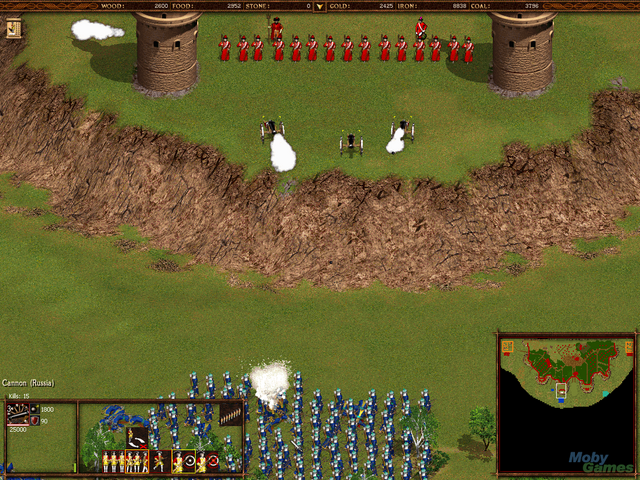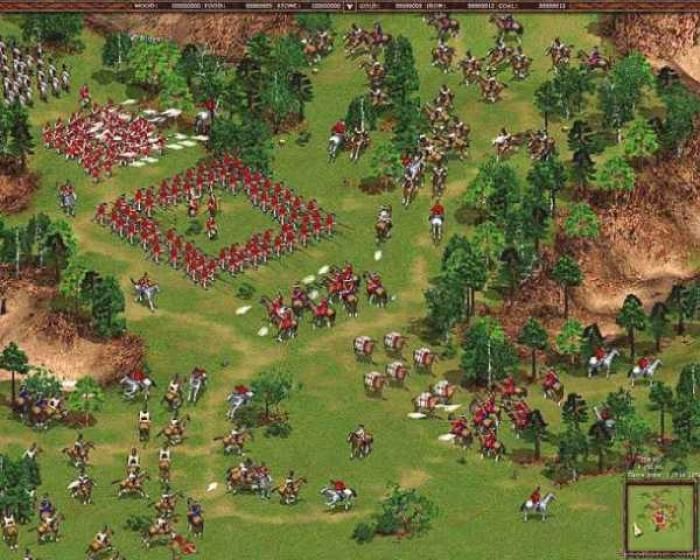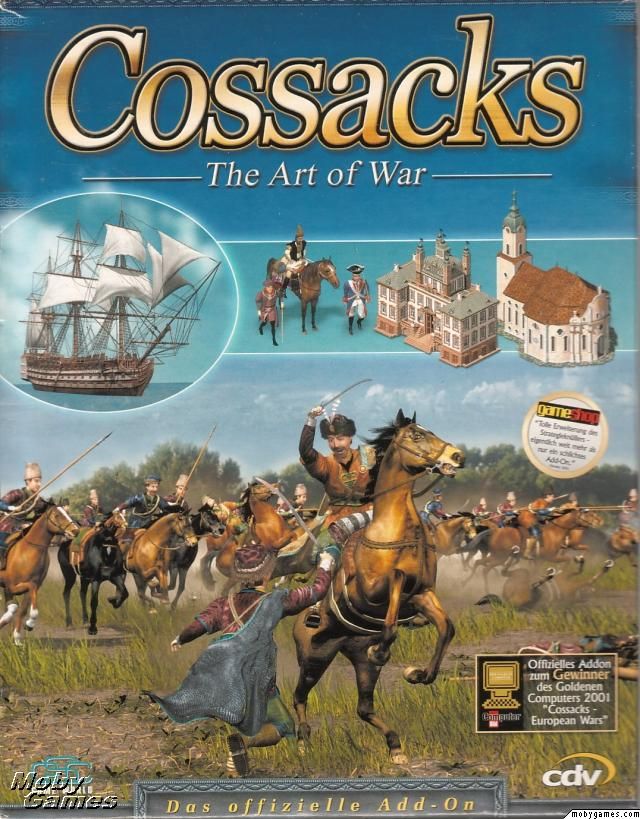Players must avoid famine and engage in army expansion, building construction and simple resource gathering. Mission scenarios range from conflicts such as Thirty Years' War to the War of the Austrian Succession, and renowned for the seemingly infinite number of units players may control. This ability set it apart from other games of the time such as Age of Empires and Empire Earth. Even today the only games that can come close to comparing to Cossacks in the area of unit count are found in the Total War series.

There are 6 basic resources in the game that are crucial to the player's military victory. These are gold, wood, food, stone, iron and coal. Gold, iron and coal may only be acquired by constructing mines over a designated resource area and sending peasants into them whereas food is cultivated from mills and via the use of fishing boats. Wood and stone are gathered by conventional means and there are also specific areas where these may be collected. Depending on the type of unit or structure being built, the amount of resources needed to create a unit/structure would inflate quantitatively with each successive one built or trained. Depleted resources would result in an undesirable penalty for the player such as a lack of food will signify a famine for the state and the player's units will die from lack of supplies. Similarly, a lack of coal and iron means that shooters and cannons will cease to fire their weapons whereas a lack of gold will mean that units which require maintenance paid will commit mutiny against the state. The economic workforce consists of peasants who can multitask and also attack enemy soldiers. They can, however, also be captured by enemy troops and turned to the enemy's allegiance.
Cossacks depart from common RTS titles in that military actions may be conducted by assigning formations to soldiers or allowing them to attack solitarily without proper formations. Formations may be made by grouping exactly 15, 36, 72, 120 or 196 of a single unit type in the presence of a corresponding officer and drummer. 3 different types of formations may be assumed and used for different attacking methods.
Units in formations may also be issued a 'stand ground' order where they would also be granted a defensive bonus as well as a morale improvement. Cavalry units may also be grouped into formations and function in a similar manner as would an infantry formation minus the officer and drummer units. Upgrades which affect weaponry and defensive stats can be researched in the barracks or the stables or the armories. An academy or a minaret (for various scientific research) is also needed to train officers and to build formations. There are various strategies of controlling an army developed by players during the continuous gaming online.

Artillery in the game are divided into mortars, cannons, multi-barrelled cannons and howitzers and all have distinct functions which are suitable in one situation but may not be appropriate in the next. Mortars are primarily used to bombard enemy buildings and ships from afar. The resulting shrapnel and debris upon impact on the building(s) would also kill nearby enemy units as well as the player's own if in the vicinity. Cannons are the staple of the artillery forces in Cossacks and possess good range (which can be improved with its corresponding research) and shot power but are not particularly powerful against buildings, especially after the buildings' upgrades have been researched. Cannons are also able to fire a grape shot to eradicate a cluster of enemies at short range whereas a multi-barrelled cannon (must be researched at the academy and is not available to all nations) also functions in a similar manner but reloads quicker than the cannon. Howitzers are the shortest ranged artillery but possess the best shot power. They fire in an arc which means that enemy walls will not block their ordnance. They are good against both soldiers and buildings but should be escorted by guards. All artillery units may be captured by enemy forces in the same manner as the peasant workforce. The main upgrades for artillery are the extended range, the accuracy and its build time and cost.
The player may also construct ships to wage naval battles and may build from a choice of yacht, galley, frigate or an 18th-century battleship. Nations which are historically not well-developed are restricted in the building hierarchy to just galleys. Turkey may build xebecs which are technologically equivalent to the Western powers' frigates. Ships are used for naval domination or for shore bombardment. A player may also build ferry units to prepare for a naval assault over large bodies of water. Larger ships typically require gold for upkeep and its crew would mutiny against the owner if the resource has been depleted.
Shooters (such as the musketeer and the strelets units) take time to reload their weapons after a volley and are vulnerable to a melee counter-attack. Ranged units also require a fair distance to be able to shoot at targets and will often retreat backwards to acquire the required distance. Different shooters possess different ranges while shooting and mounted dragoons do more damage than the regulars. Significant upgrades can be conducted to raise the level of damage possible and certain upgrades can also be purchased to halve the cost of producing shooters.
Grenadier units can destroy buildings with their grenades as well as engage enemies in both melee and ranged attacks. Military production buildings (e.g. barracks and stables) may only be destroyed by artillery and/or grenadier units whereas civilian buildings may be captured as per the usual means.
Maps
In Cossacks there is a multitude of playable, randomly generated maps in addition to five long campaigns which are considered extremely difficult to beat. These campaigns are historically accurate, and often pit the player against impossible odds.
Nations
Austria - The Austrians are one of the most diverse states in the game, having unique units in both the 17th and 18th centuries. Austria produces the 17th century Musketeers (Jäger) with the most damage, regular Roundshiers, Pandurs, and Croat cavalry.
Algeria - The Algerians, like the other Islamic nation, Turkey, cannot advance into the 18th century. They instead rely on cheap, quick-producing units and horde tactics to overwhelm their enemies. Their navy, like Turkey's, also cannot produce frigates like the Europeans, instead their shipyards build Xebecs, which match the European's 17th century battleships. Algerians may not produce the 18th century ship-of-the-line. The Algerian unique are the regular Archer and the Mameluke.
Denmark - Danish musketeers, at least in the most current netbook version, carry grenades - although unlike the dedicated grenadier, these cannot be upgraded in power.
England - English troops are all unique in the fact that they are readier quicker than all the other nations. English upgrades are different because they give a higher attack value earlier than other nations. The English unique units are the Highlander and the Bagpiper. The highlander is a long-ranged unit with no bayonet, and is built from the 18th century barracks. The bagpiper is used to form 18th century formations together with the 18th century officer.
France - The French specialize in musket-armed cavalry, as two of their unique units, the King's Musketeer and the 18th Century Dragoon fall under this classification. The third French unique unit is the Chasseur, a long-ranged infantry unit without bayonets. Players playing against France should be prepared for a French charge of 18th Century Dragoons. The French dragoon is unique because it produces faster than regular dragoons, but sacrifices its firepower.
Netherlands - Players facing the Dutch must be prepared to be rushed by Dutch 17th century Musketeers (Harquebusier), as they are the fastest-producing units of their type. This is the only Dutch unique unit. They have lesser attack than normal Musketeers, but are cheaper.
Piedmont - The Piedmontese produce Padres, the best healers in the game. They also have a 17th century musketeer which is readier faster on its IId upgrade. A few Padres used with Piedmontese regular infantry is hard to take down with units that deal below 10 damage.
Poland - Poland has four unique units, the 17th century Musketeer, the 17th century Pikeman, the Winged Hussar and the Light Rider. It has the highest attack rating of the light cavalry class, and is effective against both infantry and cavalry. Polish musketeers take the longest to produce, but are the cheapest and have an attack equivalent to their Austrian counterpart's. Polish 17th century pikemen are weak, but are produced very quickly.
Portugal - The Portuguese have no unique units, but they do, however, possess a unique building. The Portuguese Shipyard works like a tower in the fact that it may fire cannons as a defensive measure and can upgrade the number of its guns, just like a tower. Portugal has the advantage in water games where cannons, towers and walls are turned off, as its shipyard acts as a defense all by itself.
Prussia - The Prussian unique units are the 18th century Musketeer (Fusilier) and the Prussian Hussar. The Prussian Musketeer are powerful but expensive to create. The second Prussian unique unit, the Hussar, is a fast-building, rapid response cavalry unit.
Russia - The land of the czars has the most number of unique units in the game at six. However, all its unique units are produced in the 17th century. Russians can produce Spearmen, special 17th century Drummers, Commanders (instead of 17th century officers), Don Cossacks, Vityazes, and Strelets.
Saxony - Saxon players have access to one of the most effective 18th century Musketeers of the game, but it is also the one with the greatest production time. Saxon players also have the Cavalry Guard, a fast-to-create, heavy hitting, armored cavalry unit.
Spain - The Spanish have only one unique unit, but it is readily available upon building the 17th century Barracks. The Spanish 17th century Musketeer (Conquistador) is the only armored infantry shooter in the whole game. The Spanish musketeer also does not come equipped with a bayonet, and will retreat if enemy units come too close.
Sweden - The army of King Gustavus Adolphus is typified by its two unique units - the Swedish rider (knekt), and the Swedish 18th century pikeman.
Turkey - Turks specialize in infantry, cavalry and naval units, but cannot advance into the 18th century, like the other Islamic nation, Algeria. Their unique units are the Janissary, the Spakh, the Tatar and the Turkish yacht. Turkey also produces gunpowder infantry - the Janissaries. They fire from long range, and are effective when combined with light infantry or Ottoman pikemen.
Ukraine - Ukrainians produce five unique units - the Ukrainian Peasant, Serdiuk (shooter), and Cossack units. The Serdiuks are the only type of infantry that the Ukrainians can produce other than mercenaries. Ukraine is also unable to advance into the next century, much like the Muslim nations. Ukrainian Serdiuks are supposedly mercenaries themselves under the command of the Cossack Hetman, but ironically, it is the Hetman that requires gold upkeep. The other two Ukrainian unique units are the regular Sich and Register Cossacks. Sich Cossacks are the fastest cavalry units in the game, and are best used for harassing the enemy and raids. Register Cossacks are designed to mow down infantry, and are created fairly quickly. Hetman commanders are expensive, however, hetmen have a very high attack.
Venice - The Venetians are a sea power. There is nothing noteworthy of the Venetian land army - however, Venice's one unique unit - the galleass, is a testimony to the might of its navy. The galleass has two types of weapons - the cannon, fired broadside from the ship, and the ship's mortars, which have a plunging fire attack of 100. The galleass is intended for the shelling of fortresses from the sea, but is a jack-of-all-trades nonetheless.
Cossacks: Art of War
The Art of War is the first standalone expansion pack. Like the original Cossacks, the game is set in the 17th and 18th centuries, and 8000 units can be controlled. Cossacks: Art of War adds 5 new campaigns, 2 new nations (namely Denmark and Bavaria), a map editor, and 16 times larger maps with new terrains. Both new nations possess an 18th-century Musketeer unit, which have different attributes.
Link of game to download : http://adf.ly/JaB6M
size of game to download : 201.65 MB




No comments:
Post a Comment